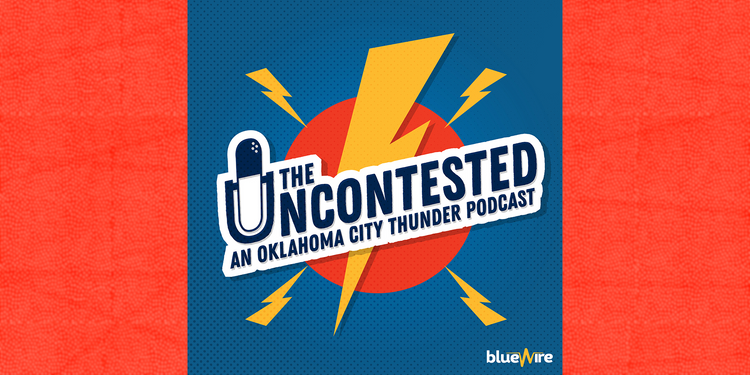The moving and shaking that was: A Thunder transaction retrospective, 2012/13


NBAE/Getty
I’ll be looking back at the moves that transformed the Thunder roster from the scary-young Finals contender in 2012 to what it is today. My aim is to evaluate and explain more than boil anything down to a simple grade, breaking down the overall moves and the decision-making behind them from season to season.
I’ve cut out some of the noise (pre-season cuts, hot potato traded contracts, draft rights to 35-year-olds, extensions, options picked up, etc.) from the layout to just focus on what actually changed about the Thunder roster, on the court, from year to year. Technically, moves in June (including draft picks) count toward the prior season’s official moves. I’ve bumped those early-summer moves ahead to represent how we pragmatically view them: moves made for the upcoming season(s).
2012/13 MovesIncoming players:
Picked: Perry Jones (28th overall draft pick), Alex Abrines (32nd overall pick),
Traded for: Kevin Martin, Jeremy Lamb, 2014 first rounder (became Steven Adams), 2014 first rounder (became Mitch McGary), Ronnie Brewer
Signed: Hasheem Thabeet, Daniel Orton, DeAndre Liggins
Outgoing Players:
Traded: James Harden, Daequan Cook, Cole Aldrich, Lazar Hayward, Eric Maynor, 2014 second rounder (became Xavier Thames)
Walked: Royal Ivey, Nazr Mohammed, Ryan Reid
In Hindsight:
The Brewers and Maynors and Thabeets, and most of the non-Harden-trade picks, were mostly inconsequential, but the general move away from a veteran backup point guard and open up space for the developing Reggie Jackson was a home run. The most organization-defining trade happened this season, though, and it shook up the NBA landscape.
I won’t rehash everything you’ve already read about the Harden deal. While the McGary and Abrines pieces could still bump the scale a bit, the rest of the puzzle is clear enough: the Thunder lost the trade pretty badly. Currently, the Thunder have one rotation piece remaining to show for the deal, which was theoretically about maintaining flexibility in the future without sacrificing a developing young core. Didn’t go as planned.
An under-hashed aspect of the notorious trade is that the rest of the league lost, too. Many other teams could have outbid what Houston gave up for Harden, but didn’t. The most fascinating what-if that we know about is the proposal Washington reportedly turned down: Bradley Beal and Chris Singleton for the bearded one. Before his injuries piled up, Beal alongside Durant, Russell Westbrook, and Serge Ibaka would have been a very nice setup for the long-term. On the other hand, had the Wizards figured out a way for John Wall and Harden to thrive together (I think they definitely would have), the KD2DC thing might look quite compelling this summer. Instead, the team is restricting Beal’s minutes and fighting just to make the playoffs as the roster stalls around Wall. What if?
Had Jeremy Lamb panned out, a long-term starting lineup featuring him and Steven Adams would have made Harden’s overnight stardom in Houston easier to swallow. Kevin Martin was a tremendous fit for the year he played in Oklahoma City, and the best Thunder team ever was this 2012/13 squad, up until Patrick Beverley collided with Russell Westbrook’s knee in the second game of the playoffs. Had the team won a title soon after the trade, or had Martin lasted longer than a year with the Thunder, the drop-off in talent would be less jaw-dropping.
Of course, had the team re-upped and earned a championship with Harden, any would-be salary constraints would have been understandable as well. And perhaps the aura of such a young potential dynasty would have drawn free agents and homegrown talents to sacrifice for a shot at more titles, a la Golden State’s current miracle of good players on good contracts.
Instead, it’s just Adams, who is a really good young center but only sees 25 minutes of playing time a night. Andre Roberson, drafted later, did eventually combine with Adams make for the kind of complementary support the team envisioned when it shipped out a max player, pivoting from featuring three all-world playmakers on the perimeter to a more balanced roster.
Roberson obviously wasn’t a direct component of the Harden trade, but I think it’s fair to factor him in while looking back. Acquiring draft picks are rarely about targeting specific players, but rather about increasing a team’s opportunities to strike gold. To say the Thunder had drafted well with their premium lottery picks prior to the deal is a seismic understatement, and they’ve continued to find good players throughout lower regions of the first round. So while Lamb and Mitch McGary haven’t amounted to much return value in the deal, those picks did give the Thunder more swings in the draft cage, and they’ve connected on other players that may have been shuffled out of their priorities and risk/reward factoring had their draft pick stockpile been lighter.
But the front office’s vision for the future roster may have been just as off the mark as their salary cap/repeater tax fears proved to be. Wing players were involved in the deal, but were either expendable or unproven. Meanwhile the team’s priority to keep Ibaka, Kendrick Perkins, and use the highest acquired pick on a big (Adams) became clear moving forward. Rather than bolstering the wing with an eye toward smaller lineups that are now taking over the league, the team reformed itself around Kevin Durant as a small forward. The optimal lineups that GM Sam Presti worked to create in the Harden wake are unplayable for many stretches of today’s games, including crunch time. That trend held steady through last season, when they replaced the fading Kendrick Perkins by adding Enes Kanter to their crowded frontcourt. But I’m getting ahead of myself.
Harden’s explosion in Houston and the Thunder’s disappointing playoff exit notwithstanding, the team still had hopes of growing and moving ahead with the same model/pieces these moves had established. It’s not dark yet, but it’s gettin’ there.

